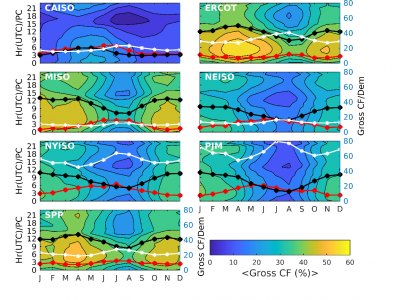Variability in Wind Power Generation
Renewable energy sources exhibit intermittency due to the geophysical drivers of the resource. Understanding the magnitudes and time scales of intermittency aids the planning of grid integration and optimized expansion of wind energy electricity generation. This analysis employs 40 years of hourly ERA5 reanalysis output, realistic wind turbine power generation curves, and verification data from the seven major U.S. independent system operators (ISOs) along with geospatial and time series analysis tools to:
- Quantify the relative importance of fundamental time scales (hourly, daily, synoptic, seasonal, and interannual) of wind-generated electricity within the major Independent System Operators (ISOs);
- Quantify the relative frequency of low generation (low capacity factors, CF) and/or ramp events with rapid declines in electricity generation for the current wind turbine fleet.
The results are verified using data from the EIA and NREL and based on the assessed fidelity are used to examine geophysically constrained theoretical scenarios of installed capacity expansion. It is shown that adding wind energy capacity near existing wind farms is advantageous even in areas with high existing installed capacity (IC) while expanding into areas with lower IC is more beneficial to reducing ramps and the probability of gross CF falling below 20%. These results emphasize the benefits of large balancing areas and aggregation (i.e. large ISOs and/or transmission connections between ISOs) in reducing wind power variability across all time scales including the likelihood of wind droughts.
Renewable energy sources exhibit intermittency due to the geophysical drivers of the resource. Understanding the magnitudes and time scales of intermittency aids the planning of grid integration and optimized expansion of wind energy electricity generation. This research quantifies key aspects of electricity generation from wind in the major ISOs and presents projections of how best to expand generation capacity to reduce intermittency.
Excluding the California ISO, the marginal probability of a calm (zero power production) is less than 0.1 in any ERA5 grid cell. When a calm occurs, the mean co-occurrence across wind turbine containing grid cells ranges from 0.38-0.39 for ISOs in the Midwest and Central Plains (MISO, SPP, and ERCOT), increasing to 0.54-0.58 for ISOs in the eastern USA (PJM, NYISO, and NEISO). Periods with low gross CF have a median duration of £ 6 hours except in California and are most likely during summer. Gross CF exhibits the highest variance at periods of one day in ERCOT and SPP, on synoptic scales in MISO, NEISO and NYISO, and on inter-annual timescales in PJM. This implies differences in optimal strategies for ensuring the resilience of supply. Theoretical scenarios show adding wind energy capacity near existing wind farms is advantageous even in areas with high existing installed capacity (IC) while expanding into areas with lower IC is more beneficial to reducing ramps and the probability of gross CF falling below 20%. These results emphasize the benefits of large balancing areas and aggregation in reducing wind power variability and the likelihood of wind droughts.

